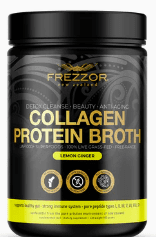Health
Unveiling the Remarkable Health Benefits of Bone Broth

Last Updated on June 6, 2023 by Nurse Vicky
Unveiling the Remarkable Health Benefits of Bone Broth
Bone broth has gained significant popularity in recent years, touted for its numerous health benefits and rich nutritional profile. This flavorful liquid, made by simmering animal bones and connective tissues, offers a wide array of essential nutrients that can contribute to overall well-being.
In this comprehensive guide, we will delve into the remarkable health benefits of bone broth, exploring its impact on various aspects of our health, from gut health and joint support to immune function and skin rejuvenation. So, grab a cup of warm bone broth, and let’s uncover the secrets behind this ancient elixir.
The Origins of Bone Broth
Bone broth traces its roots back to ancient times when our ancestors utilized every part of the animal for sustenance. They discovered that simmering bones and connective tissues over a prolonged period extracted valuable nutrients, creating a flavorful broth that provided nourishment and healing properties.
The Nutritional Composition of Bone Broth
Bone broth is a nutritional powerhouse, packed with an impressive array of vitamins, minerals, amino acids, and other beneficial compounds. It contains collagen, gelatin, glucosamine, chondroitin, and essential minerals like calcium, magnesium, and phosphorus. These components play a crucial role in supporting various bodily functions and promoting optimal health.
Promoting Digestive Health Soothing an Inflamed Gut
Bone broth’s gelatinous consistency helps soothe and repair the lining of the gastrointestinal tract,
Bone broth’s gelatinous consistency helps soothe and repair the lining of the gastrointestinal tract, making it beneficial for individuals with digestive issues such as leaky gut syndrome and inflammatory bowel disease. The gelatin in bone broth acts as a protective barrier, reducing inflammation and promoting the healing of damaged intestinal walls.
Enhancing Digestive Function
The amino acids found in bone broth, such as glutamine and glycine, support proper digestion by aiding in the production of digestive enzymes and stomach acid. These essential components help break down food more efficiently, allowing for better absorption of nutrients and reducing the likelihood of digestive discomfort.
Supporting a Healthy Microbiome
A healthy gut microbiome is crucial for overall digestive health. Bone broth contains prebiotics, which serves as food for beneficial bacteria in the gut, promoting a balanced and thriving microbial community. By supporting a healthy microbiome, bone broth can help improve digestion, enhance nutrient absorption, and strengthen the immune system.
Nourishing Joint Health
The collagen and gelatin present in bone broth plays a vital role in maintaining healthy joints. These compounds provide the building blocks for cartilage, tendons, and ligaments, helping to strengthen and support joint structure. Regular consumption of bone broth can contribute to joint flexibility and mobility, reducing the risk of joint-related conditions like arthritis.
Alleviating Joint Pain and Inflammation
The anti-inflammatory properties of bone broth can help alleviate joint pain and inflammation. Glucosamine and chondroitin, both abundant in bone broth, have been shown to reduce joint discomfort and promote joint repair. These compounds aid in the production of synovial fluid, which lubricates the joints and reduces friction, providing relief from pain and stiffness.
Strengthening Bones and Teeth
Bone broth is a rich source of minerals like calcium, magnesium, and phosphorus, essential for maintaining strong and healthy bones. These minerals contribute to bone density and help prevent conditions like osteoporosis. Additionally, the collagen in bone broth supports the health of teeth and gums, promoting dental integrity and preventing tooth decay.
Nutrient Powerhouse for Immunity
Bone broth is a nutrient powerhouse, supplying the body with essential vitamins, minerals, and amino acids that support a robust immune system. The high concentration of amino acids, such as arginine and cysteine, helps enhance immune cell function, promoting the production of antibodies and strengthening the body’s defense against pathogens.
Supporting Respiratory Health
Bone broth contains certain compounds, such as cysteine, that have been shown to thin mucus and promotes better respiratory function. This can be particularly beneficial for individuals suffering from respiratory conditions like bronchitis or common colds. The nourishing properties of bone broth can help soothe respiratory inflammation and alleviate symptoms.
Enhancing Immune Cell Function
The minerals and amino acids present in bone broth support the production and function of immune cells, such as white blood cells. These cells play a crucial role in identifying and eliminating harmful pathogens from the body. By providing the necessary nutrients, bone broth helps strengthen the immune response and enhances the body’s ability to fight off infections.
Collagen-Rich Elixir for Youthful Skin
Collagen is a key component of the skin’s structure, responsible for its firmness and elasticity. Bone broth is an excellent source of collagen, supplying the body with the necessary building blocks to maintain youthful skin. Regular consumption of bone broth can help reduce the appearance of wrinkles and promote a more supple and vibrant complexion.
As we age, our skin tends to lose its elasticity, leading to sagging and wrinkles. Bone broth’s collagen content can help improve skin elasticity by promoting the production of new collagen fibers. This results in firmer and more resilient skin. Additionally, the hyaluronic acid found in bone broth aids in maintaining optimal skin hydration, contributing to a smoother and more youthful appearance.
Reducing the Appearance of Wrinkles
The combination of collagen, amino acids, and antioxidants present in bone broth can help reduce the appearance of wrinkles and fine lines. Collagen helps plump the skin, diminishing the depth of wrinkles, while amino acids like proline and glycine support the production of elastin, which maintains skin elasticity. Antioxidants protect the skin from damage caused by free radicals, preventing premature aging signs.
Aiding Weight Loss and Metabolism
Nourishing the Body while Managing Weight
Bone broth is a low-calorie and nutrient-dense food, making it an excellent addition to a weight loss or weight management plan. It provides essential nutrients without excessive calories, helping to nourish the body while supporting a calorie deficit, which is crucial for weight loss.
Increasing Satiety and Curbing Cravings
The protein content in bone broth, combined with its rich flavor, can help increase feelings of satiety and reduce appetite. Including bone broth as part of a balanced meal or consuming it as a snack can help curb cravings and prevent overeating, supporting weight loss goals.
Boosting Metabolism and Energy Expenditure
Certain amino acids found in bone broth, such as arginine and glutamine, have been associated with an increase in metabolic rate and energy expenditure. By boosting metabolism, bone broth can assist in burning calories more efficiently, aiding in weight loss efforts and supporting overall metabolic health.
Supporting Detoxification Detoxifying Properties of Bone Broth
Bone broth contains specific compounds, such as glycine and glutathione precursors, that support the body’s natural detoxification processes. These substances assist in the elimination of toxins and waste products, promoting a healthy and efficient detoxification system.
Supporting Liver Function
The amino acids and antioxidants in bone broth, along with its nutrient-rich profile, can support liver health. The liver plays a vital role in detoxification, and consuming bone broth provides the necessary nutrients to support optimal liver function and enhance its ability to process and eliminate toxins.
Enhancing Elimination of Toxins
The gelatin in bone broth acts as a binding agent, helping to trap toxins and facilitate their removal from the body. By improving digestion and supporting the health of the intestinal lining, bone broth aids in the efficient elimination of toxins through the digestive system.
Optimizing Brain Health Nurturing Cognitive Function
Bone broth contains various nutrients that are essential for brain health. These include omega-3 fatty acids, amino acids, and antioxidants that support cognitive function, memory, and focus. Regular consumption of bone broth can provide the brain with the necessary nutrients to optimize its performance and promote mental clarity.
Promoting Neurotransmitter Balance
The amino acids present in bone broth, such as glutamine and glycine, are involved in the synthesis of neurotransmitters, the chemical messengers in the brain. Maintaining a balanced neurotransmitter profile is crucial for mood regulation, stress management, and overall mental well-being. Bone broth provides these essential amino acids, promoting neurotransmitter balance.
Protecting Against Age-Related Cognitive Decline
The antioxidants and anti-inflammatory properties of bone broth can help protect against age-related cognitive decline and neurodegenerative diseases.
Bone broth is not just a flavorful and comforting beverage; it is a nutritional powerhouse that offers a wide range of health benefits. From supporting digestive health and joint function to boosting the immune system and promoting skin rejuvenation, bone broth provides a wealth of essential nutrients that can contribute to overall well-being.
The collagen, gelatin, amino acids, minerals, and antioxidants found in bone broth work synergistically to nourish and heal the body. Whether you’re seeking relief from digestive issues, looking to support your joints and bones, or aiming to enhance your immune function, bone broth can be a valuable addition to your diet.
Incorporating bone broth into your daily routine is relatively simple. You can enjoy it as a warm, comforting beverage, use it as a base for soups and stews, or even include it in sauces and gravies to boost the nutritional content of your meals.
Remember to prioritize quality when selecting bone broth. Opt for organic, grass-fed, and pasture-raised sources to ensure that you’re getting the highest quality and most nutrient-dense broth.
The Health Benefits of Bone Broth?
If you’ve been wondering how bone broth can help your health, you’ve come to the right place. This recipe contains collagen, glutamine, and grass-fed beef, which are all extremely beneficial to the body.
These compounds are naturally present in meat and are particularly useful for restoring your health and supporting your immune system. The benefits of bone broth are numerous, and many people swear by them.
Grass-fed beef

Whether you want to optimize your nutrition and health, grass-fed beef bone broth can be an excellent choice. It is a powerful source of minerals and vitamins and one of the highest protein foods on the market.
Bone broth is made from the bones and connective tissues of various animals, such as chicken, beef, and fish. It is also highly beneficial for your joints. Below are the health benefits of grass-fed beef bone broth.
Collagen

While collagen is a vital nutrient found in the body, it is often overlooked by many people, so it is often difficult to determine whether or not this dietary supplement is right for you. Bone broth, however, contains collagen and is often a wonderful addition to any meal or snack.
Taking bone broth on a regular basis can greatly benefit your health, says Toronto integrative nutritionist Doug Cook. It can increase your glutathione levels and improve your body’s overall health.
L-glutamine
Many people believe that the L-glutamine found in bone broth is the culprit behind weight gain and a host of other ailments. In fact, this amino acid has been shown to help fight inflammation and reduce the length of colds.
Besides, the collagen content in bone broth is said to tighten the skin and reduce cellulite. You can store bone broth for about seven days by using ice cube trays or a glass container. It is best to freeze it at least two to three inches deep to avoid breakage.
Glutamine

Glutamine is an amino acid found in bones that is particularly beneficial to the gut. Glutamine reduces the amount of Firmicutes bacteria in the intestines, a group that has been linked with obesity.
Additionally, glutamine is an excellent source of protein and is known to keep people feeling full longer and prevent them from snacking. The amino acids in bone broth may also promote better sleep.
Some researchers believe that glycine is a potent anti-stress agent and is capable of helping people relax and sleep better.
calcium
Did you know that bone broth contains a high amount of calcium? Studies have shown that bones are fifty percent mineral. This is because the largest portion of the bones is calcium phosphate, which is arranged in hydroxyapatite.
Bone broth also contains trace minerals, such as magnesium, phosphorus, sulfur, and silicon. A Wisconsin research lab, Covance Labs, has tested the calcium content of homemade bone broth.
The results showed modest amounts of calcium, which is not surprising, given that we need 1,000 to 1,200 grams of calcium daily.
Magnesium

Bone broth contains essential nutrients like calcium, magnesium, and potassium. However, one study found minimal amounts of these minerals in bone broth. The rest of the nutritional value of this food is probably due to the vegetable stock it contains.
You may need to add a little bit of vegetable stock to your bone broth. To enjoy the full benefits of bone broth, it is best to use bone broth from organic sources. Here are some benefits of bone broth:
Vitamins

The gelatin in bone broth helps the body absorb water and helps the gut maintain a layer of mucus that prevents undigested food particles from entering the bloodstream.
This can support the intestinal lining and promote digestive health, as well as inhibit cytokines. In addition, gelatin is easy to digest and easily absorbs nutrients.
This makes it an excellent food choice for people with sensitive digestive systems. Vitamin D is another important component of bone broth.
electrolytes
Drinking bone broth before a workout can help your body replenish lost electrolytes and fuel before a workout. The amino acids found in collagen, gelatin, and glycine help your body repair damaged gut lining and normalize mucus membranes.
Moreover, these compounds help seal your digestive tract, reducing the risk of leaky gut syndrome. Therefore, if you are training hard and drinking lots of water, bone broth is an ideal pre-workout beverage.
Skin elasticity

If you’re looking for ways to improve your skin’s elasticity, bone broth may have the answers. This rich, collagen-rich soup can help your body produce more of its own collagen, a crucial substance for the structure of your skin.
Not only does collagen boost skin elasticity, it also helps reduce fine lines and wrinkles. In addition, collagen boosts skin cell turnover, which is essential for maintaining youthful, healthy skin.
Weight loss

You may not be familiar with bone broth for weight loss, but it is an ancient dish that has recently become more popular than ever. In fact, it is often consumed by celebrities, including Kylie Jenner, as a breakfast beverage.
Bone broth is a natural source of vitamins and minerals, as well as omega-3 and omega-6 fatty acids, which are good for our health, including fighting inflammation and regulating our blood pressure.
Additionally, many ask
What benefits can drink bone broth provide to your body?
The rich and nutritious dish known as “bone broth” includes protein, collagen, and a variety of minerals such as phosphorus, calcium, magnesium, and iron. It may help enhance the health of your bones and joints, as well as your hair, skin, and nails.
It may also assist in stimulating weight loss. According to Ben-Asher, however, it is preferable to drink it in moderation, or approximately one cup each day.
How many cups of bone broth should I have on a daily basis?
Between two and four cups. Because bone broth includes a concentrated number of substances such as collagen, glucosamine, and chondroitin, including just a few servings of bone broth in your diet, can have a profound impact on the health of your joints and the inflammation that they experience. Your daily consumption of bone broth should ideally range somewhere between two and four cups.
What changes take place in the body after a week of drinking bone broth?
People who swear by it say that the vitamins and minerals you get from the broken-down bones have powerful healing properties and that they can help to alleviate joint and gut pain, boost your immune system, brighten your skin, and even make your hair shiny.
It’s not exactly a new food (grandmothers have been making it for years), but those who swear by it say that it’s been around for a long time.
What makes bone broth such a powerful medicine?
The anti-inflammatory properties of bone broth The extended period of time that bone broth is cooked breaks down cartilage and tendons, which results in the release of anti-inflammatory compounds such as chondroitin and glucosamine sulfates.
These compounds are typically found in pricey supplements that are intended to treat arthritis and joint pain. These substances maintain the youthfulness and flexibility of your joints.
Is it safe to consume bone broth on a daily basis?
In order to reap the full range of health benefits that bone broth has to offer, it is commonly advised to consume 1 cup (237 mL) of it on a daily basis. Because having some of something is preferable to having none at all, you should try to consume it as frequently as you possibly can, whether that is once a week or once a day.
When should I consume the bone broth, first thing in the morning or last thing at night?
Bone broth is good at any time of the day; however, if you have certain health goals, we recommend planning your timing strategically in order to achieve the best possible effects.
Consuming bone broth first thing in the morning can help support healthy gut function and increase your mood. Try drinking bone broth in the evening to aid in detoxifying and building a stronger immune system.
Conclusion
In conclusion, bone broth is a versatile and nutrient-rich elixir that offers a multitude of health benefits. Whether you’re seeking to support your digestive system, strengthen your joints, enhance your immune function, rejuvenate your skin, aid in weight management, support detoxification, optimize brain health, or maintain a healthy heart, bone broth can be a valuable addition to your wellness routine.
So, why not embrace ancient wisdom and nourish your body with the remarkable health benefits of bone broth? Take a sip, savor the rich flavors, and let this ancient elixir work its magic in supporting your overall health and well-being.
Health
Protein-Infused Diet Coke: The Viral ‘Dirty Soda’ Trend Taking TikTok by Storm

Protein-Infused Diet Coke: The Viral ‘Dirty Soda’ Trend Taking TikTok by Storm
The rise of quirky, unconventional food and drink trends is a staple of social media, but one concoction that’s recently captured TikTok’s imagination is “Protein Diet Coke,” fondly referred to as a “dirty soda.”
Combining the classic fizz of Diet Coke with creamy protein shakes, this bizarre yet fascinating combination has gained traction for its unique taste, nutritional benefits, and shareable aesthetic appeal.
But is it more than just a passing fad? Let’s dive into why this drink has taken the internet by storm, the health implications, and how you can make your own.
What Is Protein Diet Coke?
Protein Diet Coke is a mashup of two popular beverages: Diet Coke, known for its zero-calorie allure, and protein shakes, a go-to choice for fitness enthusiasts.
By blending these seemingly unrelated drinks, you get a fizzy, creamy concoction that surprises the palate and offers a protein-packed twist.
This beverage has become a TikTok sensation, with videos showcasing creative ways to personalize the drink by experimenting with flavors, toppings, and presentation.
How Did Protein Diet Coke Become a Trend?
The trend began with users sharing videos of themselves trying the drink and reacting to its surprising taste.
The hashtag #ProteinDietCoke amassed millions of views as influencers and everyday users alike showcased their custom recipes. Social media thrives on novelty, and the odd pairing of soda and protein shake fits the bill perfectly.
Moreover, this trend reflects a broader shift toward incorporating fun into fitness and healthy eating. As people explore unique ways to stay healthy, Protein Diet Coke offers a mix of indulgence and nutrition.
Health Benefits of Protein Diet Coke
1. Boosts Protein Intake:
Protein is essential for muscle repair, weight management, and overall body function. By mixing Diet Coke with a protein shake, you create a delicious way to meet your daily protein goals.
2. Low-Calorie Alternative:
For those watching their calorie intake, using Diet Coke and low-sugar protein shakes keeps the drink guilt-free while satisfying cravings for something sweet and fizzy.
3. A Fun Recovery Drink:
The combination of carbonation and protein makes this drink a potential post-workout recovery option. While traditional recovery drinks are effective, Protein Diet Coke brings a fun twist to replenishing nutrients.
Possible Drawbacks of Protein Diet Coke
While this beverage has many enthusiasts, it’s not without its critics.
1. Artificial Sweeteners:
Diet Coke contains artificial sweeteners like aspartame, which some people prefer to avoid due to potential health concerns.
2. Unusual Flavor:
Not everyone loves the combination of cola and creamy textures. For some, it’s an acquired taste.
3. Limited Nutritional Value from Soda:
Though protein shakes provide nutrients, the soda itself doesn’t offer significant health benefits. Consuming it in moderation is key.
How to Make Protein Diet Coke at Home
Ingredients:
- 1 can of Diet Coke (12 oz)
- 1 scoop or 8 oz of your favorite protein shake (vanilla or caramel flavors work best)
- Ice cubes
- Optional: toppings like whipped cream, syrups, or fruit
Instructions:
- Fill a glass with ice cubes.
- Pour the Diet Coke into the glass, leaving some space for the protein shake.
- Slowly add the protein shake to the Diet Coke. Stir gently to combine.
- Customize with toppings or syrups if desired.
- Enjoy immediately!
Why Do People Love It?
The allure of Protein Diet Coke lies in its unexpected combination and social media appeal.
The drink’s unique flavor profile intrigues people, while its aesthetic presentation makes it Instagram-worthy.
Additionally, it’s a fun way to consume protein without feeling like you’re drinking a traditional shake.
Creative Variations of Protein Diet Coke
1. Mocha Protein Soda:
Add a chocolate-flavored protein shake for a mocha-inspired treat.
2. Tropical Twist:
Use coconut-flavored protein powder and garnish with pineapple slices.
3. Spicy Cola Blend:
Mix in a dash of cinnamon or chili powder for a bold kick.
4. Vanilla Caramel Float:
Top with a dollop of whipped cream and caramel drizzle for an indulgent dessert-like drink.
Is Protein Diet Coke Here to Stay?
Trends often fade as quickly as they emerge, but Protein Diet Coke might have staying power due to its flexibility and nutritional appeal. As long as social media continues to celebrate creativity in the kitchen, this quirky beverage is likely to remain a go-to option for adventurous foodies.
Conclusion
Protein Diet Coke is more than just a viral sensation; it’s a testament to how creativity can turn everyday ingredients into something extraordinary.
While it may not replace traditional sources of protein or be everyone’s cup of tea (or soda), it has undeniably carved out a niche in the world of health-conscious indulgence.
Whether you’re in it for the taste, the health benefits, or the TikTok-worthy moments, this “dirty soda” trend is worth a try.
FAQs
1. Can I use regular Coke instead of Diet Coke?
Yes, but keep in mind that regular Coke has significantly more sugar and calories, which might defeat the purpose of a low-calorie drink.
2. What type of protein shake works best?
Vanilla and caramel protein shakes are popular choices because they complement the flavor of cola. However, feel free to experiment with other flavors.
3. Is Protein Diet Coke suitable for kids?
While it’s not inherently harmful, the caffeine content in Diet Coke might not be suitable for children. Opt for caffeine-free soda if making this for kids.
4. Can I make a vegan version?
Absolutely! Use plant-based protein shakes and ensure the soda is vegan-friendly.
5. How often can I drink Protein Diet Coke?
Like any treat, moderation is key. Consuming it occasionally as part of a balanced diet is perfectly fine.
References
Health
STI Epidemic: Decline in New Syphilis and Gonorrhea Cases in the US, CDC Reports
Health
Dave Coulier Opens Up About His Battle with Stage 3 Non-Hodgkin’s Lymphoma

Dave Coulier Opens Up About His Battle with Stage 3 Non-Hodgkin’s Lymphoma
A Beloved Star Faces a Serious Diagnosis
Dave Coulier, best known for his role as Joey Gladstone on the iconic sitcom Full House, has revealed a deeply personal health challenge.
The comedian and actor recently announced his diagnosis of Stage 3 Non-Hodgkin’s Lymphoma, sparking widespread concern and support from fans worldwide.
Coulier’s bravery in sharing his journey sheds light on this complex form of cancer, its symptoms, treatment options, and the importance of early detection.
What is Non-Hodgkin’s Lymphoma?
Understanding the Disease
Non-Hodgkin’s Lymphoma (NHL) is a type of cancer that originates in the lymphatic system, which is an integral part of the body’s immune defense.
This form of lymphoma is distinct from Hodgkin’s lymphoma due to differences in the cancerous cells’ appearance and behavior.
- Lymphatic System’s Role: It helps fight infections and regulates fluid balance in the body.
- Lymphoma’s Impact: NHL occurs when lymphocytes (a type of white blood cell) grow uncontrollably, leading to tumors.
Dave Coulier’s Journey: From Diagnosis to Awareness
The Diagnosis
Coulier disclosed that he had been feeling fatigued and unwell for several months before seeking medical advice.
A series of diagnostic tests, including a biopsy and imaging scans, confirmed the presence of Stage 3 Non-Hodgkin’s Lymphoma.
How He Shared the News
In a heartfelt video shared with his fans, Coulier discussed his diagnosis candidly. The star emphasized the importance of listening to one’s body and seeking medical help when something feels off.
“I’ve always tried to make people laugh, but now, I want to use my voice to educate and inspire,” he said.
Symptoms of Non-Hodgkin’s Lymphoma
Recognizing the symptoms early can make a significant difference in treatment outcomes.
Some common symptoms include:
- Swollen lymph nodes, often painless
- Persistent fatigue
- Unexplained weight loss
- Fever and night sweats
- Abdominal pain or swelling
- Chest pain, coughing, or trouble breathing
Why Early Detection Matters
Coulier’s journey highlights the importance of not ignoring persistent symptoms. Timely diagnosis can improve treatment effectiveness and overall prognosis.
Stages of Non-Hodgkin’s Lymphoma
NHL is categorized into four stages based on its spread:
- Stage 1: Cancer is localized to one lymph node region.
- Stage 2: Two or more lymph node regions on the same side of the diaphragm are affected.
- Stage 3: Cancer involves lymph nodes on both sides of the diaphragm.
- Stage 4: The disease has spread beyond the lymphatic system to other organs.
Coulier’s diagnosis at Stage 3 underscores the critical need for awareness and early intervention.
Treatment Options for Non-Hodgkin’s Lymphoma
Tailored Treatment Plans
The treatment for NHL varies depending on the stage and specific subtype.
Common approaches include:
- Chemotherapy: Often the first line of defense to target rapidly dividing cancer cells.
- Radiation Therapy: Used to shrink tumors in localized areas.
- Immunotherapy: Boosts the immune system’s ability to fight cancer.
- Targeted Therapy: Focuses on specific molecules involved in cancer growth.
Dave Coulier’s Treatment Regimen
While Coulier hasn’t shared detailed specifics about his treatment, he expressed gratitude for his medical team and the support of loved ones.
Living with Non-Hodgkin’s Lymphoma
Physical and Emotional Challenges
Coping with cancer involves more than just physical treatments. Patients often face emotional struggles, including anxiety, fear, and uncertainty.
Coulier’s Positive Outlook
Despite his diagnosis, Coulier remains optimistic, often sharing moments of humor and gratitude. His resilience inspires others battling similar challenges.
Raising Awareness for Non-Hodgkin’s Lymphoma
The Power of Advocacy
Coulier is using his platform to spread awareness about NHL. His message encourages individuals to prioritize their health and support ongoing cancer research.
Supporting Research and Treatment Advances
Progress in lymphoma treatment, such as CAR T-cell therapy and advancements in immunotherapy, offers hope for patients worldwide.
How Fans Can Show Their Support
Messages of Encouragement
Fans have flooded social media with messages of love and encouragement for Coulier. Sharing personal stories of resilience and hope strengthens the community of those affected by lymphoma.
Donating to Lymphoma Research
Supporting organizations focused on lymphoma research and patient advocacy can make a significant impact.
Conclusion:
Dave Coulier’s openness about his battle with Stage 3 Non-Hodgkin’s Lymphoma reminds us of the importance of health awareness and community support. As he navigates this challenging chapter, his strength and advocacy serve as a beacon of hope for others facing similar battles.
FAQs
1. Can Non-Hodgkin’s Lymphoma be cured?
Yes, many cases of NHL can be treated effectively, especially when diagnosed early. Advanced treatments have improved survival rates significantly.
2. How does Non-Hodgkin’s Lymphoma differ from Hodgkin’s Lymphoma?
The primary difference lies in the specific type of cancerous cells. Hodgkin’s Lymphoma involves Reed-Sternberg cells, which are absent in NHL.
3. Are there lifestyle factors that increase the risk of NHL?
While the exact cause is unknown, factors like a weakened immune system, certain infections, and exposure to specific chemicals can increase risk.
4. What support resources are available for NHL patients?
Numerous organizations, such as the Lymphoma Research Foundation, offer resources, support groups, and financial assistance for patients and their families.
5. How can I reduce my risk of developing lymphoma?
Maintaining a healthy lifestyle, avoiding exposure to harmful chemicals, and addressing infections promptly can help lower your risk.
References:
-

 Trending Stories1 year ago
Trending Stories1 year agoCDC: 1 in 4 Americans Still COVID-Free by End of 2022
-

 Health8 months ago
Health8 months agoHow Do Pawpaw Seeds Support Cardiovascular Health?
-

 Health5 years ago
Health5 years agoMeghan Trainor Shares Motivational New Song ‘Blink’
-

 Health2 years ago
Health2 years agoHow Long Does Monkey Pox Last Before It Surfaces in the Body?
-

 Health3 years ago
Health3 years agoWhat Causes Swollen Body? Understanding Edema and its Triggers
-

 Health3 years ago
Health3 years agoNutrition and the Importance of a Fitness Program – 3 Things to Know
-

 Health3 years ago
Health3 years ago5 Weird Reasons Why Pimples Disappear After Marriage
-

 Health3 years ago
Health3 years agoHealth Benefits Of Pawpaw Seed? 7 Things To Know









